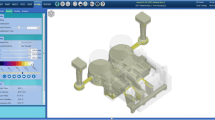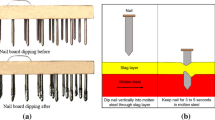Abstract
Metal casting is one of the most widely used manufacturing methods, producing many of the goods used in everyday life. Recent innovations in additive manufacturing (AM) have allowed for more complex mold and rigging designs to produce higher-quality castings. One of the limiting factors preventing widespread adoption of these complex designs, however, is the inability to fully visualize and characterize the metal flow in these molds. This paper examines the use of open molds to evaluate liquid metal flow to better understand the flow characteristics that will ultimately influence casting performance. The study investigated two types of open molds along with two types of cameras to find the best method for evaluating the melt flow. The open molds used were direct 3D sand printed molds, and green sand molds made with AM patterns. The cameras used were a camera with a higher optical magnification but lower frame rate, and a camera with no optical magnification but a higher frame rate. The video from both cameras was processed using a video analysis algorithm to identify the melt head and calculate its change in position and velocity along the path of the runner. Additionally, the results from the experiments were compared against computational fluid dynamics (CFD) simulations, showing that CFD underpredicted the melt head velocity by 58%. Findings from this study can complement CFD models for evaluating mold design. Additionally, new training tools can be developed using this method to improve pouring control and consistency for foundries.















Similar content being viewed by others
References
W.E. Frazier, Metal additive manufacturing: A review. J. Mater. Eng. Perform. 23, 1917–1928 (2014)
American Foundry Society. Castings. Wherever You Are. | American Foundry Society. https://www.afsinc.org/castings-wherever-you-are.
American Foundry Society. Metal Casting Matters for Pennsylvania. (2020).
American Foundry Society. Metalcasting Industry Impact on U.S. Economy.
N. Hawaldar, J. Zhang, A comparative study of fabrication of sand casting mold using additive manufacturing and conventional process. Int. J. Adv. Manuf. Technol. 97, 1037–1045 (2018)
R. Banchhor, S. Ganguly, Optimization in green sand casting process for efficient, economical and quality casting. Int. J. Adv. Eng. Technol. 5, 25–29 (2014)
M.A.A. Khan, A.K. Sheikh, B.S. Al-Shaer, Evolution of metal casting technologies—a historical perspective. Appl. Sci. Technol. (2017). https://doi.org/10.1007/978-3-319-46633-0_1
M. Upadhyay, T. Sivarupan, M. El Mansori, 3D printing for rapid sand casting—a review. J. Manuf. Process. 29, 211–220 (2017)
J.M. Walker et al., Real-time process monitoring of core shifts during metal casting with wireless sensing and 3D sand printing. Addit. Manuf. 27, 54–60 (2019)
E.S. Almaghariz et al., Quantifying the role of part design complexity in using 3d sand printing for molds and cores. Int. J. Met. 10, 240–252 (2016)
T. Sivarupan et al., A review on the progress and challenges of binder jet 3D printing of sand moulds for advanced casting. Addit. Manuf. 40, 101889 (2021)
H.B. Henderson et al., Additively Manufactured Single-Use Molds and Reusable Patterns for Large Automotive and Hydroelectric Components. Int. J. Met. 14, 356–364 (2019)
J. Runyoro, S.M. Boutorabi, J. Campbell, Critical Gate Velocities for Film-Forming Casting Alloys: A Basis for Process Specification. AFS Trans. 100, 225–234 (1992)
Campbell, J. Complete Casting Handbook: Metal Casting Processes, Metallurgy, Techniques and Design: Second Edition. Complete Casting Handbook: Metal Casting Processes, Metallurgy, Techniques and Design: Second Edition (2015). https://doi.org/10.1016/C2014-0-01548-1.
S.R. Sama, T. Badamo, P. Lynch, G. Manogharan, Novel sprue designs in metal casting via 3D sand-printing. Addit. Manuf. 25, 563–578 (2019)
S.R. Sama, J. Wang, G. Manogharan, Non-conventional mold design for metal casting using 3D sand-printing. J. Manuf. Process. 34, 765–775 (2018)
King, P., Martinez, D. & Manogharan, G. P. Novel Sprue Designs to Reduce Casting Defects in Nickel-Aluminum Bronze: A computational Study. In Proceedings of the ASME 2020 15th International MSEC 1–9 (2020).
Stebbins, R., King, P. & Manogharan, G. A computational study on novel runner extension designs via 3D sand-printing to improve casting performance. In Proc. ASME 2021 16th Int. Manuf. Sci. Eng. Conf. MSEC 2021 1, 1–9 (2021).
H. Shangguan, J. Kang, C. Deng, Y. Hu, T. Huang, 3D-printed shell-truss sand mold for aluminum castings. J. Mater. Process. Technol. 250, 247–253 (2017)
J. Kang et al., Additive manufacturing-driven mold design for castings. Addit. Manuf. 22, 472–478 (2018)
M.M. Shuvo, G. Manogharan, Novel riser designs via 3D sand printing to improve casting performance. Procedia Manuf. 53, 500–506 (2021)
J. Walker, E. Harris, C. Lynagh, et al., 3D printed smart molds for sand casting. Inter. Metalcast. 12, 785–796 (2018). https://doi.org/10.1007/s40962-018-0211-x
Campbell, J. An overview of the effects of bifilms on the structure and properties of cast alloys. Metall. Mater. Trans. B Process Metall. Mater. Process. Sci. 37, 857–863 (2006).
B. Sirrell, M. Holliday, J. Campbell, Benchmark testing the flow and solidification modeling of Al castings. Jom 48, 20–23 (1996)
Sama, MacDonald, Voigt & Manogharan. Measurement of Metal Velocity in Sand Casting during Mold Filling. Metals (Basel). 9, 1079 (2019).
M.A. Irfan, D. Schwam, A. Karve, R. Ryder, Porosity reduction and mechanical properties improvement in die cast engine blocks. Mater. Sci. Eng. A 535, 108–114 (2012)
S.G. Acharya, J.A. Vadher, M. Sheladiya, A furan no-bake binder system analysis for improved casting quality. Inter. Metalcast. 10, 491–499 (2016). https://doi.org/10.1007/s40962-016-0059-x
Flow Science. Flow-3D Cast. at (2018).
M. Jolly, Casting simulation: How well do reality and virtual casting match? State of the art review. Int. J. Cast Met. Res. 14, 303–313 (2002)
A. Kumaravadivel, U. Natarajan, Application of Six-Sigma DMAIC methodology to sand-casting process with response surface methodology. Int. J. Adv. Manuf. Technol. 69, 1403–1420 (2013)
S.G. Liu et al., Characteristics of mold filling and entrainment of oxide film in low pressure casting of A356 alloy. Mater. Sci. Eng. A 626, 159–164 (2015)
S. Kashiwai et al., Numerical simulation and X-ray direct observation of mould filling during vacuum suction casting. Int. J. Cast Met. Res. 18, 144–148 (2005)
D.Z. Li, J. Campbell, Y.Y. Li, Filling system for investment cast Ni-base turbine blades. J. Mater. Process. Technol. 148, 310–316 (2004)
Khalajzadeh, V., Goettsch, D. D. & Beckermann, C. Real-time X-ray Radiography and Computational Modeling of Shrinkage Porosity Formation in Aluminum Alloy Castings. Metall. Mater. Trans. A Phys. Metall. Mater. Sci. 50, 757–771 (2019).
Canon. VIXIA HF G20. https://www.usa.canon.com/internet/portal/us/home/products/details/camcorders/consumer/vixia/vixia-hf-g20 (2021).
GoPro. HERO8 Black. https://gopro.com/en/us/shop/hero8-black/tech-specs?pid=CHDHX-801-master (2021).
Panasonic. Lumix DC-GH6. https://www.panasonic.com/ca/consumer/cameras-camcorders/mirrorless-cameras/micro-four-thirds/dc-gh6.html.
Voxeljet. Material data sheet voxeljet 3D printers. at (2021).
American Foundrymen’s Society. Alternative Utilization of Foundry Waste Sand. (1991).
Federal Highway Administration. User Guidelines for Waste and Byproduct Materials in Pavement Contruction. (2016).
OpenCV. Open Source Computer Vision Library. at (2020).
Flow Science Inc. Flow-3D Cast. at (2021).
Acknowledgements
The authors would like to thank Travis Richner and Brent Johnston with helping to setup and pour the castings. This material is based upon work supported by the National Science Foundation (NSF) under Career Award, #1944120 and National Science Foundation Graduate Research Fellowship (NSF-GRFP) under Grant No. DGE1255832. Any opinions, findings, and conclusions or recommendations expressed in this publication are those of the authors and do not necessarily reflect the views of the National Science Foundation.
Author information
Authors and Affiliations
Corresponding author
Ethics declarations
Conflict of interest
The authors do not have any competing interests.
Additional information
Publisher's Note
Springer Nature remains neutral with regard to jurisdictional claims in published maps and institutional affiliations.
Rights and permissions
Springer Nature or its licensor (e.g. a society or other partner) holds exclusive rights to this article under a publishing agreement with the author(s) or other rightsholder(s); author self-archiving of the accepted manuscript version of this article is solely governed by the terms of such publishing agreement and applicable law.
About this article
Cite this article
King, P., Manogharan, G. Novel Experimental Method for Metal Flow Analysis using Open Molds for Sand Casting. Inter Metalcast 17, 2892–2903 (2023). https://doi.org/10.1007/s40962-023-00966-2
Received:
Accepted:
Published:
Issue Date:
DOI: https://doi.org/10.1007/s40962-023-00966-2




